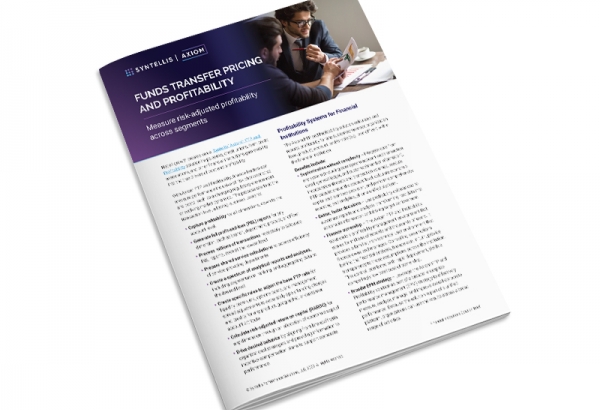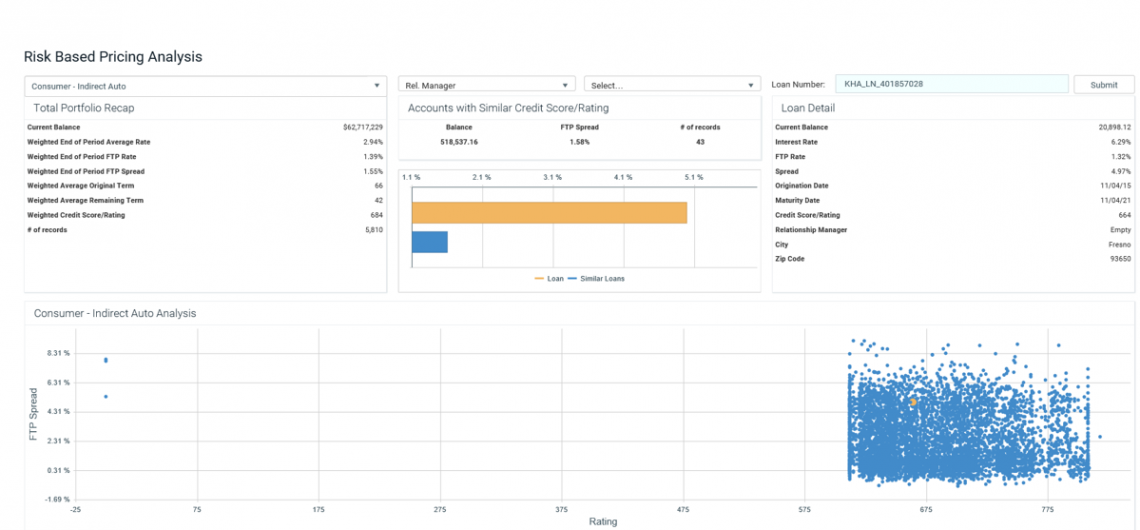Funds Transfer Pricing in Banking
Accurately Analyze the Profitability of Your Financial Institution
The Basics of Funds Transfer Pricing
What is Funds Transfer Pricing (FTP)?
Funds Transfer Pricing (FTP) is a critical tool for accurately measuring a financial institution’s profitability. It enables you to measure and analyze net interest margin (NIM) for every segment (like products, customers/members, officers, and departments) of a financial institution.
What is Net Interest Margin (NIM)?
Net Interest Margin is a measure of the difference between the interest income generated on assets and the amount of interest paid for liabilities, relative to the amount of (interest-earning) assets.
Why is Net Interest Margin important?
Net interest margin is typically a bank's largest source of profit, representing 50-90% of a financial institution’s net income. Therefore, it's vital to consistently and accurately measure and analyze net interest margin.
What roles does FTP play in the measurement of Net Interest Margin?
The general ledger enables you to measure net interest margin on an aggregate basis for the entire institution. To understand net interest margin at a more granular level, you need to use Funds Transfer Pricing (FTP).
Funds Transfer Pricing lets you accurately measure the cost or credit of funds to support precise profitability measurement, effective budgeting and planning, and better pricing analysis. This, in turn, supports improved margin management, branch analysis, product and marketing strategies, as well as customer or member profitability.
The 3 components of Funds Transfer Pricing are the asset spread, liability spread, and residual spread.
- The asset spread (credit spread) is the net interest margin earned by funds users, generated by assets such as loans, investments, and fixed assets that receive an FTP charge.
- The liability spread (deposit spread) is the net interest margin earned by funds providers on products that provide funding for the institution such as savings, checking, CDs, and institution borrowings that receive an FTP credit.
- The residual spread is the margin that your Treasury/Funds Management group earns by ensuring adequate liquidity and managing interest rate risk exposure and other risks.
71% of Financial Managers have limited confidence in their institutions’ ability to forecast and manage profitability performance with current financial planning processes and tools.
There are 3 common approaches to transfer pricing the balance sheet including:
- Net funds transfer pricing. In a net funds approach, you net all assets and liabilities for each profit center and ascribe a cost/credit to the shortage/excess of funding for the branch/unit. While simple to implement, it has several flaws, including the inability to analyze net interest margin below the branch/cost center level, a lack of support for pricing analysis, and it leaves the risk to the margin in the branch, where they cannot manage it.
- Pool-based transfer pricing. In a pool-based approach, you create funding pools such as short-, medium-, and long-term, assigning each product or portfolio to one of the pools. The funds transfer pricing rate assigned to the pool then determines the transfer rate and margin for every account in the pool. While easy to implement and administer, a pool approach provides little confidence in the numbers and has no buy-in from line managers as it doesn’t take into account the attributes of each account (such as origination date, amortization pattern, etc.).
- Matched-term transfer pricing. Also called matched maturity, this is the most widely accepted approach to transfer pricing. In a matched-term approach, you transfer price at the individual instrument/record level based on its characteristics, such as origination date, term, options, and expected cash flows. It requires a funding desk function to centralize how instruments are priced and rated, with oversight from Treasury.
While more time consuming to implement and more complex to administer, a matched-term approach is the most accurate and widely-used method to calculate FTP. It has several advantages, such as consistency (in most cases, both sides of the balance sheet are valued against a single market yield curve), insulation from interest rate risk changes, and improved margin management, allowing you to disaggregate margin into its proper components. This is the approach used by our Axiom FTP & Profitability software.
"With Axiom, we achieved 83% time savings for our monthly funds transfer pricing report, reducing from 3 days to a couple of hours."
- SVP, Managing Director of Finance, $6.4B Bank
How do I take FTP to the next level?
Funds Transfer Pricing is the first step in a cohesive profitability management framework. To extract more value from FTP, calculate full profitability using all data available within your institution. To do so, you need to factor in additional components of profitability and further leverage analytics, as detailed below.
1. Factor in additional components of profitability
The benefits of FTP can be further enriched when combined with other processes such as cost, provision, and capital allocations, resulting in a complete view of risk-adjusted profit contribution. The additional components of profitability include:
- Service Transfer Cost Allocation – The process of allocating centralized costs to profit centers based on consumption or use. Note there are also direct costs/income associated with products, organizational units, etc. that may need to be allocated to the instrument level
- Loan Loss Allocation – The process of allocating provision for loan loss based on credit risk
- Capital Allocation – The process of allocating capital to allow measurement on a risk/return basis
- Multi-Dimensional Reporting – The ability to flexibly slice and dice profitability data and results so it can be analyzed at any level (customer/member, officer, product, branch, etc.).
2. Leverage analytics
In addition to full profitability, there are other uses of Funds Transfer Pricing, especially in a comprehensive analytical framework, such as:
Risk-Based Pricing Analysis
By adding the relevant credit score to each customer record, you can determine whether your institution, and even individual loan officers, are being adequately rewarded based on the risks associated with each loan. You may not even realize the need to enforce stricter guidelines when it comes to pricing lower-quality credits; plotting margin against credit score can provide this insight. The following Risk-Based Pricing Analysis aggregates this information by product:
Evaluate Loan Originations and Pricing by Officer
By focusing on recent activity rather than a sum of historical lending decisions, you gain data that is more actionable and lets you course correct. It also provides a basis for incentive compensation that aligns with profitability goals. To ensure your bank is aligning behavior with corporate profitability goals, banks often use incentive compensation software.
Consider the Time Dimension
To get a full picture of performance, it is important to not only look at current performance, but also to leverage funds transfer pricing in assessing historical performance and forecasted performance.
Analyze historical performance to help establish historical pricing trends and ongoing issues. This analysis helps you answer questions such as:
- Which loan products are profitable?
- Which branches are losing money?
- Do deposits contribute to profits?
- Which clients and relationships are most profitable for my institution?
Analyze forecasted performance to support strategic planning, budgeting, forecasting and risk analysis, making plans based on profit vs volumes. It can help you answer questions such as:
- Which products should you invest in?
- How did each branch perform according to plan?
- Are you being appropriately compensated for credit risk?
- How should we set our goals (based on profit, not volume)?
“We get good FTP numbers by the end of the first day of month-end close, speeding up the reporting process. We can now do reports on the fly; they are really simple, and we can knock them out in a few hours. It used to take us days to find all the data and definitions to build the reports.”
Want to learn more about Funds Transfer Pricing?

Understanding Profitability Through Funds Transfer Pricing

Takes profitability management to the next level with Axiom Software

Extracting More Value from Funds Transfer Pricing

Axiom FTP and Profitability Management: Financial Institutions Solution Brief

How Funds Transfer Pricing Analysis Can Help Reshape Your Margins

Reduces report processing time from 5 days to 5 hours

Funds Transfer Pricing For Profitability Measurement
Analyze and Manage FTP with Axiom Software
Axiom Software's Funds Transfer Pricing & Profitability empowers your finance team to make the best decisions regarding product pricing, the opening and closing of branches, which customers you should be targeting, and other profitability drivers.
Maximize value from FTP investments today. We look forward to partnering with you.

